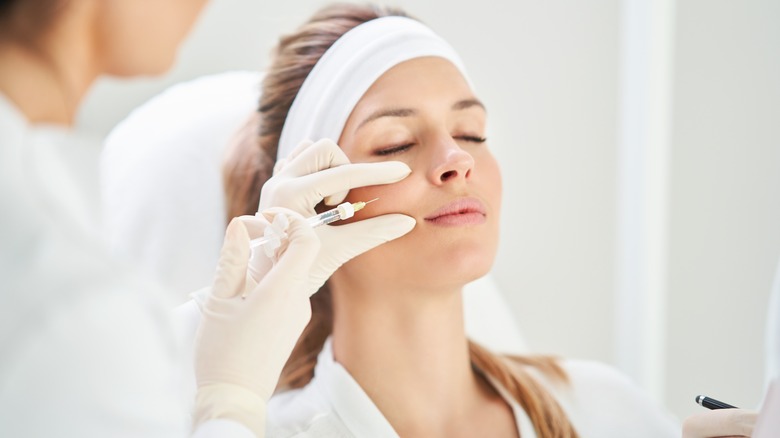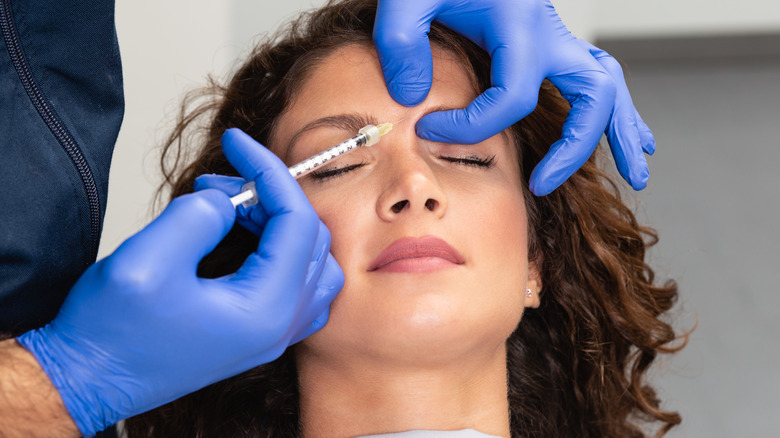What's The Difference Between Botox And Xeomin?
Wrinkles and fine lines are an unavoidable part of the natural aging process. While healthy lifestyle choices like avoiding sun exposure, not smoking, and eating a diet rich in antioxidants might help delay the onset of visible skin aging, it cannot be prevented completely (via the American Academy of Dermatology Association). Before the 2000s, the only real choice to rewind the clock was to undergo expensive and invasive plastic surgery. These procedures require general anesthetic, the side effects of which can be severe on rare occasions, according to the Mayo Clinic.
Fortunately, in today's world, there is a gray area between largely useless wrinkle creams and risky cosmetic surgery. Residing in that area are highly effective non-invasive temporary injectable treatments. For nearly a decade, Botox was the only product of this sort available. Today, however, there are additional treatments that have been approved to treat facial wrinkles. Here is a closer look at Botox and the popular comparable cosmetic injectable, Xeomin.
Botox basics
Botox is, by far, the most popular injectable treatment for wrinkles on the market. Over 7 million people in the U.S. alone receive Botox treatments and the global industry is worth a whopping $4.4 billion, as reported by Solomon Cosmetic Center. The treatment hit the market in 2002 and is now so synonymous with cosmetic wrinkle-reducing injections that many people refer to any type of similar treatment as Botox, even if its actually produced by another brand.
Since Botox is a botulinum toxin injectable, it works by interrupting nerve signals and temporarily weakening facial muscle contractions, as detailed by the Mayo Clinic. Relaxing these muscles results in the diminishing of fine lines and wrinkles in the skin. The treatment is approved for forehead or brow wrinkles and crow's feet, and results can be seen almost immediately. It is also approved to treat medical issues like migraines, excessive sweating, muscle spasms, and urinary incontinence.
Xeomin basics
Xeomin is a more recent arrival to the world of cosmetic botulinum toxin injectables, approved in 2010 (via Drugs.com). The formula claims to be "cleaner" than Botox because it lacks the proteins present in Botox that may lead to an immune response. "There are no significant studies to prove this," Dr. Lucy Chen, M.D., tells Health, explaining that the correlation between those uneccessary proteins and immune responses is still just a theory. In reality, the difference really only affects the way the product can be stored by clinicians.
There is a possibility, though, that the lack of these proteins could help with the prevention of the development of antibodies, the production of which can lead to a loss of the positive effects of injectables, per American Academy of Facial Esthetics. This hypothesis is in the early phases, however, and so far has not been proven by any large studies.
Xeomin works in the same basic way as Botox and there are few differences in the effects most people will experience after injections. Xeomin is only approved to treat frown lines, along with medical issues like neck or arm spasms, eye twitching, and drooling. That said, it has been found by the medical community to also be a safe treatment for forehead lines and crow's feet, even though this is not what it was approved for, per Spa Black.
The effects of Xeomin will appear over about a three-day period of time, similar to Botox injections, and peak after about two weeks. Some patients do report seeing results more quickly with Xeomin (via Beauty 2.0 Aesthetics).
How to choose between Botox and Xeomin
Botox and Xeomin are very similar medications that are administered the same way and at about the same frequency. They can both produce the same mild side effects, which include pain in the injection area, bruising, and eyelid drooping. There is also the risk of the medication spreading beyond the treatment area for both injectables. When this happens, serious side effects like difficulty breathing or swallowing, blurred vision, severe muscle weakness, voice changes, and even botulism infection can take place. Botox does carry a higher risk of muscle weakness, while Xeomin is more likely to cause headaches, according to GoodRx.
While Xeomin is technically slightly less costly than Botox, individual clinic prices vary widely enough that it's unlikely consumers will see the difference. There are practitioners who have reported seeing more patients become resistant to the effects of Botox than to Xeomin due to a lower risk of antibody production (via Allen Foulad MD Facial Plastic Surgery). While this has not been scientifically confirmed, it is a potential factor to consider before choosing a treatment, in addition to speaking with your treating medical professional.



